This hillfort, located on the left bank of the Dūmė Stream, is steeped in history and legend. Its oval platform, oriented east-west and measuring 5×8 meters, is surrounded by a prominent rampart, ranging in width from 6 to 11 meters. Particularly impressive in the western part, the rampart reaches up to 3.5 meters in height, while in other places it is about 1 meter high. Nearby, to the west, lies an impressive ditch, 25 meters wide and 1 meter deep. The ancient castle's slopes, rising to heights of 5–9 meters, add to the dramatic and mysterious atmosphere of the site.
Legend speaks of a tragic fate that befell a noblewoman, who, according to the tale, was ordered by her cruel stepmother to be buried in this hill. When the nobleman returned and learned of the horrific crime, he rushed to save his daughter. The depression in the hill where
the stepmother carried out her grim plan remains to this day.
Other tales associate this hillfort with pagan altars and rituals, spreading ancient traditions and beliefs. There are also thoughts that this place was constructed during the era of serfdom through hard labor, commemorating the local people's desire for freedom and well-being.
In the 19th century, landowner J. Rimševičius, while excavating the hillfort, reportedly found a clay pot filled with tar, said to have been covered with lime. This further confirms the historical and cultural significance of this place.
To reach this enigmatic site, one must travel along the Žiežmariai-Žostautai road, passing Kibučiai and turning westward. Although the hillfort is overgrown with dense vegetation, it is a valuable site to visit, revealing the secrets of our region's past.




 Entertainment
Entertainment
 Sightseeing
Sightseeing
 Food establishments
Food establishments





























 54.747972, 24.389722
54.747972, 24.389722
 Get directions
Get directions









